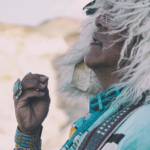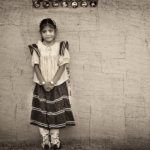Writer Amanda Christmann
Photographer Scott Baxter
[dropcap]A[/dropcap]rizona is unique. Perhaps it’s the subtleties of the seasons that make us appreciate life’s moments all the more, or maybe it’s the resilient, scrappy people who live here despite the formidable desert heat, but the people who stay, whether for a decade or for generations, have more in common than we have differences.
Children
In 2013, the Mesa Tourism Bureau hired Baxter to photograph people and events on the Fort McDowell Yavapai Nation, a tiny 950-member Native American tribe whose reservation is located 35 miles from Phoenix.
The children pictured were originally photographed in the tourism shoot, but Baxter saw an opportunity to capture something special. In his trademark fashion, something much deeper than childhood comes out in his pictures.
The Fort McDowell Yavapai people once roamed over 12 million acres, but were forced by a 1903 executive order to locate to a 40-square-mile reservation in northeastern Maricopa County. In the 1970s, the tribe had to fight when the proposed Orme Dam project was slated to be built adjacent to their land. Had it been built, it would have flooded many homes and farms. The Fort McDowell Yavapai won their fight in 1981, and each year, they hold a fair and rodeo to celebrate their victory.
Today, the Fort McDowell Yavapai Nation owns the Radisson Fort McDowell Resort and Conference Center, Fort McDowell Casino, Fort McDowell Adventures, Eagle View RV Resort, WeKoPa Golf Club, Fort McDowell Farms, Yavapai Materials and Sedona’s Poco Diablo Resort.
Today, the lines are often blurred between Arizona’s cultures, religions and heritage. For millenniums, Native American people hunted, farmed and prospered here. Their oft-neglected stories form the foundations of how we all came to survive in the harsh, arid desert, and how our economy, our agriculture, and even our political boundaries evolved into what we now know.
Horses
For Navajo people, Jones Benally and his family are nearly legends. They are world-famous hoop dancers, and their horsemanship skills and innate equine talents are widely regarded. His son Clayson (shown left) is a horse trainer, an environmental activist and member of the Navajo band Black Fire.
The photographs in this portion of Baxter’s series were taken at the base of Doko’oosliid, the Navajo word for Flagstaff’s San Francisco Peaks. Some of Clayson’s clothing was contemporary, but some very traditional, a testament to the dual existence of Native philosophy and Western influence within his life.
Sheep
Navajo churro sheep are used for both wool and food. Brought by Spanish settlers in the 16th century, Pueblo people were hired and enslaved to herd sheep and weave textiles, and they were a food and clothing staple for both the Spanish and area tribes.
In the mid-1800s, Navajos began to resist occupation by the miners, ranchers and other settlers who’d begun encroaching in large numbers on Diné homelands. Kit Carson and John Carlton were ordered by the U.S. Government to raid Navajo villages and destroy their orchards and flocks.
This military action led to the Long Walk of the Navajos, in which an estimated 9,000 Navajo people were forced on a 300-mile trek to an interment camp at Bosque Redondo, New Mexico.
There is no official number of the people who died along the way, but the human and livestock toll was immense. Some Navajos who escaped were able to hide in remote canyons with their sheep, and survived that terrible chapter in history.
Three years after it began, Navajos were allowed to return to their native lands and were issued two sheep per person—considered enough to survive, but not enough to thrive.
People
Photographing indigenous people comes with unique challenges. Baxter avoids contrived narratives, but he also knows that, for many of the native people he has come to know, there is great pride in wearing traditional ceremonial clothing.
“I don’t treat Native Americans any differently than when I’m shooting cowboys, when I’m shooting kids, when I’m shooting other friends, or when I’m shooting my daughter. They show up, and my job is to make a connection.
“For me its more about the person—how you relate to that person, and how they relate to you. It’s getting something deeper from them.
“I’m particularly conscious of being respectful, and there’s so much that I don’t know. I become a conduit in a sense, but it’s not about me. I just hope that they trust me enough to be authentic.”
Pottery
Nestled in eastern Arizona’s South Fork Canyon near the sleepy town of Greer is Little Bear Ruins. From about 500 to 900 A.D., ancestors of both the Hopi and Zuni people thrived in this former village. Today, blessings are still performed here, and people have the opportunity to explore the past.
The pottery and shards are real, and one can’t help but wonder about the hands that created them. Lost in the unwritten annals of time, gone too are the dreams, thoughts and memories of these people who came before.
Scott Baxter
About the Photographer
I was born in Hartford, Connecticut. I grew up near Princeton, New Jersey, and I moved to Phoenix in 1982. I currently live in Carefree.
I have been a professional photographer since 1986. I was teaching school and one of my ninth grade English students taught me how to process black and white film. I decided then that I wanted to become a photographer instead of going to law school.
I am inspired to photograph Native Americans because of their reverence for our world.
Photography is very subjective. I have always thought that you can tell a lot about a person by viewing their photographs. It’s really pretty simple; I try really hard to make my photographs straightforward, simple and honest.










Comments by Admin